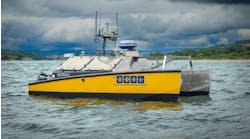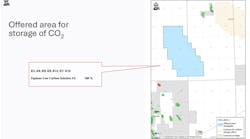Jeremy Beckman • London
null
Denmark pins hopes on newcomers
Exploration activity in Danish waters is set to intensify, following the award of 14 new licenses this year by Denmark’s government. In its latest annual review, the Danish Energy Agency (DEA) says the combined 6th Licensing Round programs carry a commitment for a total of seven firm wells and 12 contingent wells, with an overall investment pledge of around DKr 2.3 billion.
Four of the successful bidders are also first-time operators on the shelf. One of them, Wintershall, recently detailed plans to start drilling on its three blocks in 2008. Wintershall is also a majority shareholder in a neighboring concession, block 11/98, where state company DONG has been drilling for gas this summer. If the outcome is successful, the discovery will be tied back to Wintershall’s A6-A production platform, 7 km away in the German sector.
Last year, DEA adds, the total Danish acreage covered by new seismic surveys was the largest in the sector for over five years. WesternGeco conducted 3D and 4D campaigns on Maersk’s behalf in the Central Graben, in the far southwest of the Danish shelf. Most of the interest among licensees, DEA says, is split between discovering new hydrocarbon accumulations and proving extensions from existing fields.
As for Danish oil production, this has hovered around the 20 bcm mark for the past five years. A big factor in maintaining that level has been the increased use of water injection; one of the more successful methods of displacing oil in recent years has involved banks of horizontal wells arranged in a pattern of alternate producers and injectors, with parallel well trajectories.
Latterly, Fracture Aligned Sweep Technology has achieved further gains. Initially, the injector wells inject water at low pressure, with the rock stress field aligned parallel to the well. Water injection pressure then is increased, causing the rock to fracture along the well trajectory. This creates a continuous water front along the length of the injector well, driving the oil in the direction of the producer wells.
Rig constraints stifle exploration
Rig shortages have put the brakes on UK exploration drilling, according to a new report from analyst Wood Mackenzie. The company forecasts a total of 63 new exploration and appraisal wells across the UK shelf this year, way below the 2005 tally of 87, which was an eight-year high.
“Operators have indicated that there are numerous opportunities waiting to be drilled,” says Europe Upstream Research Analyst Alison Sheppard. However, although the number of rigs active in UK waters has risen by 15% this year, the focus has shifted towards development drilling to accelerate production while oil prices remain high, she adds.
Despite the drop in well numbers, five operators achieved a total of seven discoveries during the first half of 2006, representing an exploration drilling success rate of 39%. The average size of the finds was a modest 15 MMboe, all being virtual “step-out” wells less than 20 km from existing production infrastructure. Some operators, however, have been drilling higher risk wells in frontier regions, and Sheppard points out that “continued appraisal of West of Shetland discoveries such as Lochnagar and Alligin through the second half of 2006 could have a big impact on future activity in this area, if successful.”
Since the report, Canada’s Antrim Energy has confirmed a strong test result from its well on the East Causeway prospect in the far northern UK sector. The well, drilled by the semisubmersibleBredford Dolphin, was drilled through the Osprey Ridge Trend, a series of fault-bounded, staircase-like structures extending northeast from block 211/22 SE into block 211/23d, which contain two undeveloped finds from 1984 and 1992.
In July, the latest well (211/23d-17z) intersected 360 m of net oil-bearing Mid-Jurassic Brent sandstones; a follow-up test in August on a fault compartment in Jurassic Ness and Tarbert reservoirs flowed at a stabilized rate of 14,500 b/d. The same well intersected Brent sandstone intervals from the suspended 1992 discovery well 211/23b-11, flowing up to 8,100 b/d. East Causeway has been suspended for use as a potential producer, pending development decisions, which include possible integration with other oil discoveries in the area. Nearest fixed platforms, should the partners take that route, are Shell’s Dunlin and Osprey installations.
Peak Well Management, which drilled the well on Antrim’s behalf, believes that current rig constraints could be solved by short-term “sub-lets”. This is what the Aberdeen-based contractor has done in the case of the jackupEnsco 92, which BP had booked on a long-term charter. Peak has taken advantage of “windows” in the contract to use the rig for current exploratory wells in the southern gas basin for three small independents, Silverstone SNS, Serica Energy, and Granby Oil and Gas.
Venture expands gas portfolio
Venture Production has acquired CH4 Energy, a UK-based gas production company with interests on either side of the Dutch/British North Sea median line. The main asset is the Markham gas complex, developed originally by Lasmo in the early 1990s. Markham produces through two fixed steel platforms; a new compression platform is currently being added, which next year will handle supplies from CH4’s Chiswick and Newfield’s Grove fields, both under development on the UK side.
Under the transaction, Venture also picks up a 20% interest in the Windermere and J/3c fields (both already tied back to Markham), and a 25% stake in the 165-km, 500 MMcf/d ETS trunkline system to the northwest, which serves Perenco’s Trent and Tyne and ATP’s Tors fields. Total proven and probable reserves acquired amount to 184 bcf, with forecast production from the various interests rising to 67 MMcf/d next year.
In the Norwegian/UK median line area, Sweden’s Lundin Petroleum has paid Total $45 million for interests in three blocks containing the undeveloped 20 MMboe Peik field, and a marginal gas discovery. Subject to the UK/Norwegian unitization agreement, Lundin expects an imminent development, probably as a subsea tieback to a nearby platform.
Island breakthrough in Celtic Sea
In Ireland’s Celtic Sea, Island Oil & Gas has tested gas successfully from its second well in the sector, on the Old Head of Kinsale prospect. Well 49/23-1, drilled by the semisubmersiblePetrolia in 296 ft of water, encountered a Lower Cretaceous reservoir sequence with a gross 100-ft gas column, as determined from pressure data. This is the first new discovery in the region since 1990.
Island believes the gas may extend over an area of 22 sq km, with potential volumes of up to 120 bcf. The location is 25 km from the sole production facilities in the area, on Marathon’s Kinsale field.




